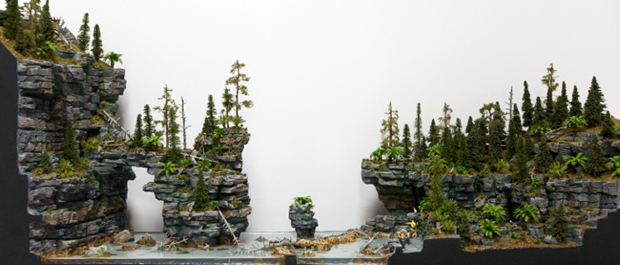Corfe Castle at sunrise

The fabulous ‘Jurassic Cove’ a key part of the Jurassica project on the Isle of Portland, has been unveiled in the form of a fully detailed 1:100 scale model.
Jurassica, the world’s most spectacular prehistoric visitor attraction, is to be built on the Isle of Portland in Dorset. It will celebrate the extraordinary geological heritage of the Jurassic Coast, a UNESCO World Heritage Site since 2001. Jurassica has the backing of Sir David Attenborough, who is the project’s Patron.
As well as a series of galleries displaying many of the fossil treasures unearthed along this coast during the past 200 years, the estimated 600,000 annual visitors will be able to literally walk 150 million years back in time to stand on a Jurassic seashore, and see first-hand the extraordinary alien environment in which dinosaurs trod the land, fantastic sea monsters patrolled the seas and flying pterosaurs screeched through the skies.
The ‘Jurassic Cove’, the name coined by the project’s exhibit designer David Lazenby, of Azureus Design Ltd, is now taking shape.
In incredible detail, the scale model shows how visitors will walk through a lost world of strange plants, Araucarias, cycads and ferns, the living fossils of the botanical word ruled by reptiles and with a climate very different to that of today.
The Cove will utilise a large part of the 250,000 cubic metre volume of Yeoland’s Pit, Jurassica’s chosen site and an old aggregate and Portland Stone quarry.
Under a translucent roof designed by architect Renzo Piano, visitors will walk onto a seashore littered with shells – not of today’s limpets and cockles, but of ammonites and the large Jurassic oysters that lived in the tropical seas, lagoons and beaches in which the rocks that now form Dorset were laid down.
Lazenby, whose credits include Gondwana Praehistorium, a major dinosaur attraction in Schiffweiler, Germany, the aquarium and rainforest environments at the California Academy of Sciences in San Francisco and last year’s summer dinosaur spectacular at the Eden Project, said he believed that the Jurassic Cove will be ‘the largest immersive prehistoric exhibit in the world’ when Jurassica opens in 2021.
‘We will use both the fantastic natural strata and recreated rock faces to show just what a Jurassic seashore would have looked like, complete with pterosaurs perching on the rock ledges,’ he says. “The cove will also feature a salt water lagoon, sea caves, rock stacks, arches, living corals and other ancient marine organisms.”
Many theme parks and museums claim to recreate past environments but, according to Jurassica’s CEO Michael Hanlon, what will make the Portland project stand out is its scientific authenticity.
“The Cove is a thing of beauty and a work of genius,” Hanlon says. “David is simply the best person in the world at making you believe you have left our world and entered another,” he adds. “We had to have him on board. What makes Azureus Design stand out – aside from the unparalleled ability to create a lifelike , atmospheric environment – is its designers’ insistence on getting it right. “Think of our Jurassic cove as a really detailed museum diorama, but on a vast scale,” says Lazenby.
“Too many ‘dinosaur exhibits’ lazily rely on a few palm trees and tree ferns and a vague impression of a swamp, their designers happy to depict organisms that didn’t even exist in the Mesozoic and taking a mix-and-match attitude to species that is wholly unrealistic.
“We will pick a specific period in prehistory and everything you see will be both realistic and an accurate representation of the plants and animals that were alive at that time.
“The Jurassic Cove will not be a theme park display, but a spectacular and precise snapshot in time that will bring the heritage of the Jurassic Cove to life for the first time. Dorset – or rather the rocks that formed it – was a wildly different place to today, 150 million years ago. These rocks – the limestones, clays, sands and chalks of the county – were formed close to the equator in an almost unrecognisable world. What we are trying to do is to bring home just what a strange and alien planet Earth was back then.”
Jurassica, a registered charity, is currently at the planning, design and fundraising stage and has applied for a major £16m grant from the Heritage Lottery Fund. The total project cost is £80m. It has the backing of the Royal Society and the Natural History Museum and last year was awarded a £300,000 grant by the Dorset Local Enterprise Partnership, as part of the Government’s Local Growth Deal.